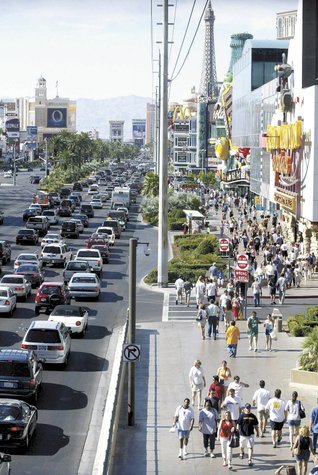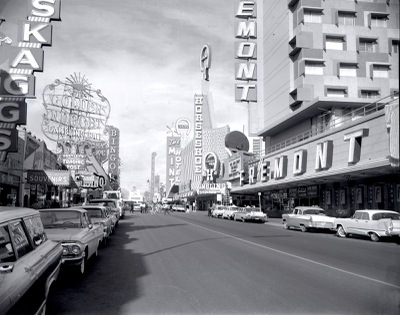
Contrary to plans, Paul Goldberger says, the Las Vegas Strip has become a place where crowds of people walk and gather at all hours.
Saturday, May 3, 2008 | 2 a.m.

Paul Goldberger
In Today's Sun
Sun Archives
Beyond the Sun
The views of architecture critic Paul Goldberger took some urban planners by surprise in Las Vegas this week, even jolting some into derisive chortles.
But the more than 1,000 planning specialists from around the world listening to the Pulitzer Prize winner’s talk had difficulty dismissing his argument that the rest of the world is learning from Las Vegas.
“As cities become less and less manufacturing centers, they develop more avenues for culture and entertainment, both of which Vegas has cultivated for decades,” Goldberger said after a one-hour talk at the American Planning Association’s 100th annual conference at Paris Las Vegas this week.
Because the meeting was held here, many of the hundreds of sessions held in conference rooms, and through walking and bus tours, focused on Las Vegas.
How Las Vegas and New York similarly deal with sex workers was analyzed in one session. Another featured a tour of local parkland and a discussion of federal land policy. And homelessness was looked at in a tour titled “A Homeless Plan That Works.”
Goldberger’s keynote speech may have been one of the conference’s most memorable for the simple reason that the former New York Times architecture critic put into words thoughts and ideas that rarely enter the minds of those who don’t live here. Mainly, that although it’s easy to see Las Vegas has taken from the world — the Venetian, Paris, New York-New York — few believe the rest of the world is beginning to mimic Las Vegas.
As cities spawned from now-dying heavy industries struggle for survival, some are pouring money into tourism, service and entertainment to bolster local economies. It’s what Vegas — and right now, we’re talking about the Strip — has mastered for decades.
“Today, almost every older city is becoming more and more a place of culture and entertainment, less a place of manufacturing, more a place of service businesses and health and education and tourism and leisure,” Goldberger said. “Every city is becoming more like Las Vegas, we might almost say.”
Goldberger, who now writes for The New Yorker and is a design professor and former dean at Parsons The New School for Design in Manhattan, also said something that might seem heresy to residents who avoid the Strip: He sees the Strip as having created an urban environment — if urbanism is defined as a place people want to be, where people walk, go to people-watch and get out in the day and night.
“The Strip was created to get away from the conventional city, and yet the conventional city — well, not truly the conventional city, but let’s just say the idea of urbanism — caught up with it,” he said.
Evidence, he said, can be found in the hordes found there at all hours.
“One thing that is amazing about the Strip ... is the presence of all of those thousands of people out strolling the Strip at night, sauntering from casino to casino like pilgrims wandering from church to church in Rome,” Goldberger said.
“This is urbanism in spite of itself — urbanism in spite of the builders of every building showing total indifference to it.”
There’s no question that people love their cars.
“But it is true that if you give people something they want to see, and create a situation in which, for whatever reason, it is not particularly practical to use a car, and you make walking pleasurable and even exciting — well, then people will walk,” he said.
“The Strip is the ultimate example of the street that was not designed for walking, and people are walking on it.”
Goldberger brought his audience through a history of development, “four generations” that focused on changes to the entertainment and gaming industries.
He defined the first generation as the pre-World War II era, when Fremont Street was king and before the advent of the Flamingo, Stardust and other Las Vegas Boulevard properties.
The second was heralded by the construction of those Strip casinos, whose oversized signs became more iconic than the structures themselves. The third generation came with the megaresorts — such as the Mirage, MGM Grand and New York-New York — buildings so massive and distinctive they served as signs themselves.
And now comes the fourth generation, a landscape not yet built, exemplified by the $8 billion CityCenter and its “starchitects.”
How this new generation will fare, Goldberger wasn’t certain.
“I’m not sure what these people can bring to the party, and their dilemma in Las Vegas is a difficult one, because they obviously don’t want to design things that are just like the work they have done elsewhere,” he said. “But neither do they want to design anything that looks too much like what is now in Las Vegas.”
What’s clear, he added, is that “Las Vegas’ desire to make itself a kind of theme park of highlights from the rest of the world has not disappeared.”
While there’s no denying Las Vegas has a character all its own, the differences between it and other cities of the world are shrinking, Goldberger said.
“I don’t mean that every city will become Las Vegas, and I absolutely don’t mean to forgive this city’s obvious shortcomings,” he said. “I don’t find a 50,000-room or whatever hotel amusing because it has a fake mansard roof.
“But if we put that aside for a moment and try to understand the realities of Las Vegas now ... we see a place that really does show us much of what people want out of cities.
“They want grandeur and excitement and novelty and stimulation. They want to come to a city for what they cannot get on the Internet. It is not a bad set of things to want, and as we try to figure out how to provide these things in other places, and how to build cities that have the sustaining, nurturing qualities that this city undeniably lacks, we have to admit that we can still, even now, be learning from Las Vegas.”


Join the Discussion:
Check this out for a full explanation of our conversion to the LiveFyre commenting system and instructions on how to sign up for an account.
Full comments policy